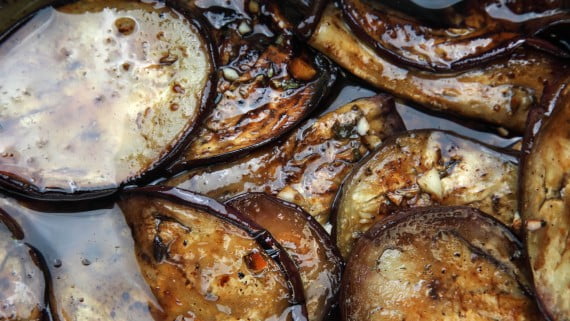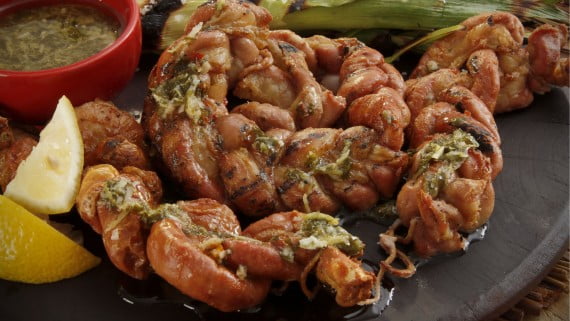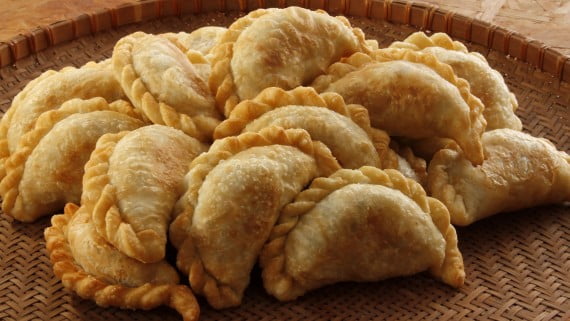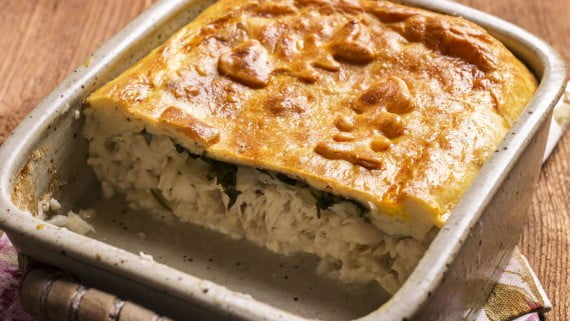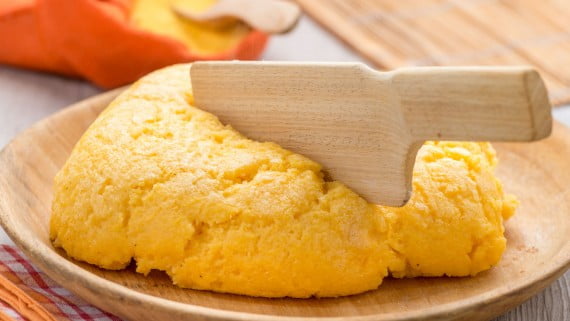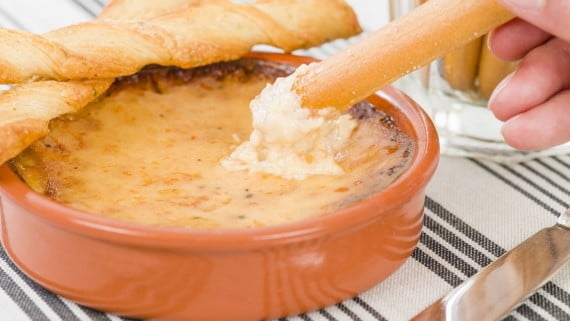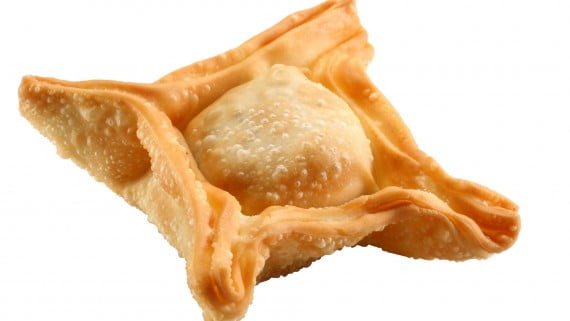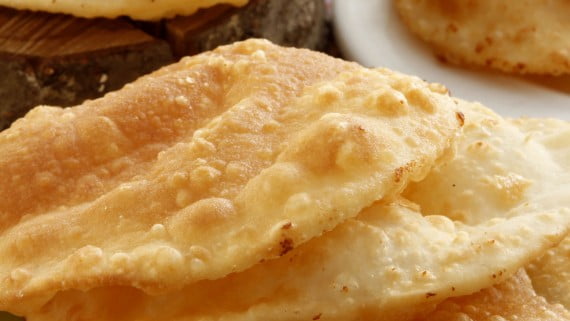The gastronomy of Argentina differs from other Latin American countries because it has European influences, especially from Spanish cuisine and the Italian gastronomy. Argentina is also one of the world's largest agricultural producers of wheat, corn and beef. In what follows we show you the main dishes, sweets and typical drinks of this country.
Below you have an index with all the points that we are going to deal with in this article.
Article Index
- 1.
- 1.1.
- 1.2.
- 1.3.
- 1.4.
- 1.5.
- 1.6.
- 1.7.
- 1.8.
- 1.9.
- 1.10.
- 1.11.
- 1.12.
- 1.13.
- 1.14.
- 1.15.
- 1.16.
- 1.17.
- 1.18.
- 2.
- 2.1.
- 2.2.
- 2.3.
- 2.4.
- 2.5.
- 2.6.
- 2.7.
- 2.8.
- 2.9.
- 2.10.
Main courses
The flavors of the main dishes of Argentine cuisine are a reflection of the Italian and, at the same time, the Spanish influence. For this reason, many of the dishes mentioned below are original from Italy. Likewise, Argentine roasts have acquired worldwide fame for their peculiar way of preparation.
asado
When talking about Argentine cuisine, undoubtedly the first dish that should be mentioned is the famous Argentine barbecue. It is a parrillada in which different parts of beef are cooked on the grill or in the heat of the fire.
When a barbecue is made, the person who does it is called spit o barbecue and it must take into account a series of aspects about the meat, namely: the cut, how to salt it, its point, the cooking times, the type of grill to use ...
The pieces of meat are usually placed horizontally, although there are other methods, such as spit, which consists of a metal shaft in which food is pricked, widely used also in brazilian cuisine.
A variant of this method is the spied on cross o roasted to the cross, in which the meat is arranged in a cross shape on the grill. Roasts are usually prepared with beef, lamb or kid. This dish is also very popular in the gastronomy of Ecuador or the Mexican Kitchen, Among others.
Pickled eggplants
Pickled aubergines are a dish of homemade and they take a considerably long process of elaboration. You need at least 1 kg of aubergines, which must be sliced at least 1 cm wide.
Subsequently, they should be boiled for a few minutes and then stored in a glass jar with plenty of oil accompanied by finely chopped garlic, parsley and oregano and boiled again for half an hour.
Finally, they should be kept in a dark and dry place for at least 10 days. The normal thing is to take this dish as a incoming next to a glass of wine and cheese.
Carbonada
Carbonade is a kind of stew very popular in Latin American cuisine, especially in Chilean, Bolivian and southern Peruvian cuisine, where it is also known by the name of locro.
Carbonada is traditionally prepared in a saucepan or pot over a wood stove. The classic recipe includes, among others, the following ingredients:
- Squash
- Soft corn or corn
- Beef, lamb or goat meat
- Potatoes
- Dried peaches
All this is boiled until the broth acquires a thick consistency and, later, it is seasoned with oregano, paprika, onion, thyme, quitucho pepper, etc.
Italian food
Italian immigration was the largest migratory movement experienced in Argentina, and is currently the European community with the most presence in the Argentine Republic.
Therefore, it is not surprising that Argentina's gastronomy is strongly influenced by the Italian cuisine.
Possibly the Italian food more consumed is the pizza, followed by fainá (flour in Italian), pasta in general, milanesa, cheeses and pasta frola.
Chimichurri
The sauce named chimichurri It has a liquid consistency that includes a wide variety of ingredients to enhance its flavor, among which you cannot miss:
- Parsley
- Garlic
- Vinegar
- Oregano
- Ground chili
- Olive oil
- Sal Island
Although it is widely consumed in Argentina, it is also taken in Paraguay and Uruguay. It is usually used as dressing for main dishes, such as roast, choripán and salads, as well as for marinating fish. It should be kept in the refrigerator in an airtight container.
chitterlings
The term chitterlings comes from Old Medieval English and is used to refer to the guts or the small or large intestine of the cattle.
The secret is that the chinchulines are crisp and well toasted. They are usually cooked together with the Argentine barbecue and are eaten as an accompaniment.
Chinchulines that are cooked with the small intestine are usually presented in the form of a braid, while if the large intestine is used (called in Argentina ocote o fat belly), it is cooked in a similar way, but it is filled with the same ingredients as the chorizo.
Choripan
Choripán is another of the star dishes of Argentine cuisine and stands out above all for the simplicity of its preparation, in addition to its flavor. The term choripan is actually an acronym for sausage, which is usually abbreviated as chori y pan.
The plate basically consists of a sausage which is cooked on the grill and served between two pieces of bread, usually French bread or marraqueta, similar to a sandwich or sandwich.
The type of chorizo used is Creole, also called barbecue, with a soft consistency and raw appearance, made from 70% beef and 30% from pork. It is usually seasoned with Chimichurri sauce or pebre.
Empanadas
Empanadas are, along with asado and choripán, another of the Argentine dishes par excellence. In fact, empanadas are popular in many other Latin American countries, as well as among the spanish tapas.
Specifically, the empanadas from Argentina have a semicircular shape not exceeding 20 cm in diameter and are closed with the so-called repulse, which can be made by hand or with a fork and whose shape, in many cases, is an indicator of the ingredients that the filling contains.
The filling of the empanadas is known as message o carbonated. Although the ingredients vary according to regions, the most popular empanadas are those from Tucumán, Buenos Aires, Catamarca, Chaco and Cordovan, among others.
Fish pie
The fish empanada is a variant of the famous empanadas that we have talked about previously. For the filling, you can use any type of fish, always to the taste of the diner, although the most common are tuna (fresh or canned), sardines and hake.
Even several types of fish can be mixed. You need dough for savory cakes, either homemade or prepared, and, in addition, other ingredients are included in the mixture: tomatoes, onion, peppers, oil, egg, olives ...
Faina
Faina is an adaptation of the term flour, from the Genoese dialect and whose meaning is made with flour.
As we have already commented previously, fainá is another dish that has been installed in the gastronomy of Argentina and that Italian immigrants brought to the country between the XNUMXth and XNUMXth centuries.
Fainá is usually consumed as pizza side and, in fact, it is placed on top of each slice of pizza, so that they are taken at the same time.
locro
El locro (from the Quechua language ruqru o luqru), known as Argentinian locro o Creole locro It is a tradition in Argentina more than a simple main dish included in its gastronomy.
This food is usually consumed on May 25, a day considered a national holiday in which Argentina's Day of the Fatherland is celebrated, and on July 9, Argentina's Independence Day.
Therefore, the locro is a family celebration symbol or with those closest to you. The basic ingredients of this dish are: corn, squash, onion, beans, bay leaf, cumin, pork and / or beef and salt.
Milanese
Milanesa is another of the star dishes in Argentine cuisine and owes its origin to Italy, specifically, to the city of Milan, hence its name.
Since the nineteenth century, when Italian immigrants began to arrive in Argentina, it has been a common dish in Argentine cuisine, Paraguayan, Uruguayan and Bolivian cuisine.
The Milanese consists of a fine steak of beef that is coated in crushed egg and breadcrumbs, and then fried in oil. Normally, it is taken to the plate, that is, served on a plate with puree, chips or salad.
However, it is also common to take it in a sandwich, a dish known as Milanese sandwich o Milanese bread and that can include lettuce, egg, tomato, cheese ... In case of including all these ingredients, it is called complete.
Sting
Picada is a typical starter in Argentina and also in Uruguayan cuisine. In Spain, it is usually called stiff And it is also eaten as a starter or as a cover. However, it is very similar to appetizer Italian.
It is a dish that includes several ingredients in small quantities, among which there are usually those mentioned below: ham, cheese, bread, black pudding, mortadella, salami, pieces of Milanese, pizza, pate, fish, chickpeas, pickle in vinaigrette, mushrooms ...
Polenta
Polenta is an original dish from the northern region of Italy, but, today, it is consumed in most of Europe (Austria, Bosnia, Portugal, Slovenia, southern France ...) and in Latin America, especially in Argentina, where it is taken especially in the coldest months of the year.
The most common way of preparation is accompanied by tuco (sauce made from tomato, onion and beef) and grated cheese (usually Parmesan). Argentine polenta tends to have a fairly thick consistency, to the point that it is sometimes necessary to cut it with a very fine string called tweety.
Provoleta
The provoleta is actually the name of a commercial brand of cheese that refers to the Argentine spun provolone cheese.
It is characterized because it is a cheese that was created to be grilled or grilled, so that it is thick and with a golden appearance.
It is usually taken as a companion to meats, sausages and minced meat. Once melted, a little oregano is sprinkled on it and olive oil is added on top. It is also common to take it with bread.
Sorrentines
Sorrentinos are another of the dishes that are inherited from the Italian influence within Argentine cuisine.
It is a type of stuffed pasta similar to Italian ravioli that usually includes ham, cheese and ricotta, although these ingredients may vary depending on the region where they are prepared.
Thus, there are also spinach, salmon, brie cheese, mozzarella cheese, raw ham, prawns, squash, onions, tomato sauce ...
Vitel Tone
Vitel toné is an original dish from Italy, specifically from the Piedmont region, where it is known as vitel tonné in Piedmontese dialect or as Vitello tonnato in Italian.
Like other dishes already mentioned, it has become very popular in Argentina, as well as Uruguay. These are beef fillets that are accompanied by a sauce whose ingredients are:
- Tuna
- Hard-boiled egg
- Anchovy
- Milk cream
Capers can also be included. It is a dish that is usually eaten at Christmas dinners, on holidays or at family celebrations. It is taken cold as a starter.
Stuffed zucchini
Pumpkin is a vegetable that belongs to the family of squash, zucchini and the like. Specifically, the pumpkin (from the Quechua language: sapallu) is the most popular variant in America, where it is also known as pumpkin.
Pumpkins, when they are yet to mature and their skin is soft, are called zucchini. It is a very easy dish to prepare and consists of filling them with egg, cooked ham, bread crumbs, grated cheese, onion, butter and olive oil. They are cooked in the oven.
Sweets and drinks
Argentina has a wide variety in its dessert and sweet menu. The presence of dulce de leche stands out above all, used in a large number of recipes, such as flan with dulce de leche or pastafrola, among others. Citrus and tropical fruits are also very present.
Cornstarch alfajores
Cornstarch alfajores are a typically Latin American sweet, although they are original from the time of Al Andalus (where his original Spanish-Arabic name was al-hasu, whose meaning is filling) and were introduced to America in the pre-colonial era.
Alfajores have been marketed by different brands, namely: Jorgelin, baglet, suchard, cachafaz… However, the traditional recipe for its preparation includes the following ingredients in the filling:
- Butter
- Eggs
- Sugar
- Vanilla extract
- Special corn starch to prepare alfajores
- Self-rising flour
- Dulce de leche for the filling
- grated coconut
Said filling is placed between two or more cookies. In some variants, they bathe in chocolate, sugar o glazed.
Clericó or clericot
Clericó or clericot is a fruity alcoholic drink very similar to Spanish sangria. Apart from Argentina, it is widely consumed in Paraguay and other Latin American countries.
In addition, it is usually taken on holidays, especially at Christmas and the end of the year parties. It is similar to the Ecuadorian dessert known as eat and drink and it is prepared with citrus and tropical fruits.
Since all the ingredients are mixed with wine, avoid adding watermelon between the fruits, as there is a popular belief that the combination of wine and watermelon has harmful side effects for health.
Invoices
Invoices in Argentina are a tradition and a symbol of the hospitality of its inhabitants, since it is usual that, if visitors are received at home, they come accompanied by a plate of invoices.
They consist of a wide range of Bakery It is taken to accompany cooked mate, coffee with milk or mate. They can be filled with dulce de leche, sweet potato, quince paste or pastry cream.
The best known invoices are the croissants, which we will talk about below, the black cakes, the Berlin ones or friar balls, the palm trees and the sweet milk cannons, among others.
Dulce de leche
Dulce de leche is a kind of very thick syrup or sauce, brown in appearance and whose flavor is largely reminiscent of caramel. It is considered a delicacy, which is why it receives other names such as manjar, manjar blanco, cajeta o arequipe.
It is similar in texture to condensed milk and is, in fact, considered to be a caramelized variant of it. Its consumption has spread to all Latin American countries, France (milk jam in French), Spain and the United States.
It can be taken alone or as accompaniment to other sweets, such as alfajores of cornstarch, ice cream, cakes, fried cakes, pancakes, flan ...
Martin Iron
The so-called Martín Hierro consists of quince jam, sweet potato or guava accompanied by slices of cheese. It is a simple dessert that does not require a preparation process.
It is popular in Uruguay and also in Argentina, where the way of taking it varies by region. Thus, in the northwest of the country it is eaten with goat cheese and cayote or tuna sweet, and, on the other hand, in the northeast they opt for fresh cheese.
In the south, sheep's cheese is used accompanied by sweet elderberry, raspberry or maqui, and in the coastal areas bitter orange sweet is used. The version for which sweet potato and fresh cheese is used is called fresh and sweet potato.
Mate
The word matt comes from the Quechua term but to you, which actually means pumpkin, since this infusion is prepared with the fruit or leaves of yerba mate (ilex paraguariensis).
This plant is grown mainly in the basins of the Paraguay and Paraná rivers, and is a very traditional drink in the Río de la Plata region. It has a bitter taste because it contains tannins and, in addition, it is sparkling and stimulating, because it also contains caffeine.
This infusion is considered to have digestive properties, purifying and preserving the body, as it contains antioxidants. The traditional thing is to take it hot in a container called matt, Cuya, guampa o porongo, and with the help of a straw called bulb.
half moons
Croissants are the classic croissant which is taken in Spain and France (in French croissant) as part of the breakfast and they come from Austria.
Medialunas are actually consumed throughout Latin America, where they are also known as little horns, crabs y little bits, and they are kind of puff pastry buns, yeast and butter.
Although they can be taken without filling, there is the possibility of adding different creams inside, including:
- Dulce de leche
- Chocolate
- Almond flour
- Custard cream
The croissants are included within the set of pastries known as bills. You can also add a salty filling, such as cheese, ham or sausages.
Pastafrola
Pastafrola, pasta frola, pasta flora or pastaflora, in Italian shortbread, is a very popular artisan cake in Argentina, as well as in Paraguay and Uruguay. Its origin is Italian, which is why it is very similar to the pie.
The fundamental difference between pastafrola and crostata is that the former it is filled with quince paste and, the second, jam, which can be strawberry, dried fruit, peach, apricot ...
There are Argentine variants in which the quince paste is replaced by the famous dulce de leche or also by sweet guava or sweet potato.
One of the main characteristics of the appearance of this cake is that the upper layer is decorated with strips made with the same dough with which the base is made. It is cooked in the oven and is a typical sweet to accompany an infusion of mate at any time of the day.
Sweet potato cupcakes
Sweet potato pastries are another of the most popular desserts in Argentina, whose dough is prepared with flour, butter, eggs, a little salt, baking powder and pella fat for frying.
They are filled with Sweet Batata, although there are some variants in which it is replaced by quince paste or dulce de leche.
Although these pastries can be found throughout the year in bakeries and patisseries, they are especially traditional during the festival of May 25 or Argentina's Day of the Fatherland. It is common to take them with hot chocolate.
Fried cakes
Fried cakes are a classic in Argentine cuisine and are usually eaten with mate. This dessert is very easy to prepare and is usually homemade.
Although taken throughout the country, they are especially popular in the Rio de la Plata region. Furthermore, it is tradition to take them on rainy days or bad weather, because there are those who consider that this is a way of thanking the Virgin Mary for the rain for being beneficial for agriculture.
There are other popular beliefs that trace the consumption of fried cakes on rainy days to Argentine gauchos. They are prepared with flour, fine salt, pork or beef fat and milk. Finally, they are fried in plenty of oil.
This article has been shared 1226 times. We have spent many hours collecting this information. If you liked it, share it, please:


